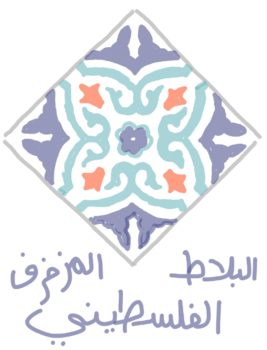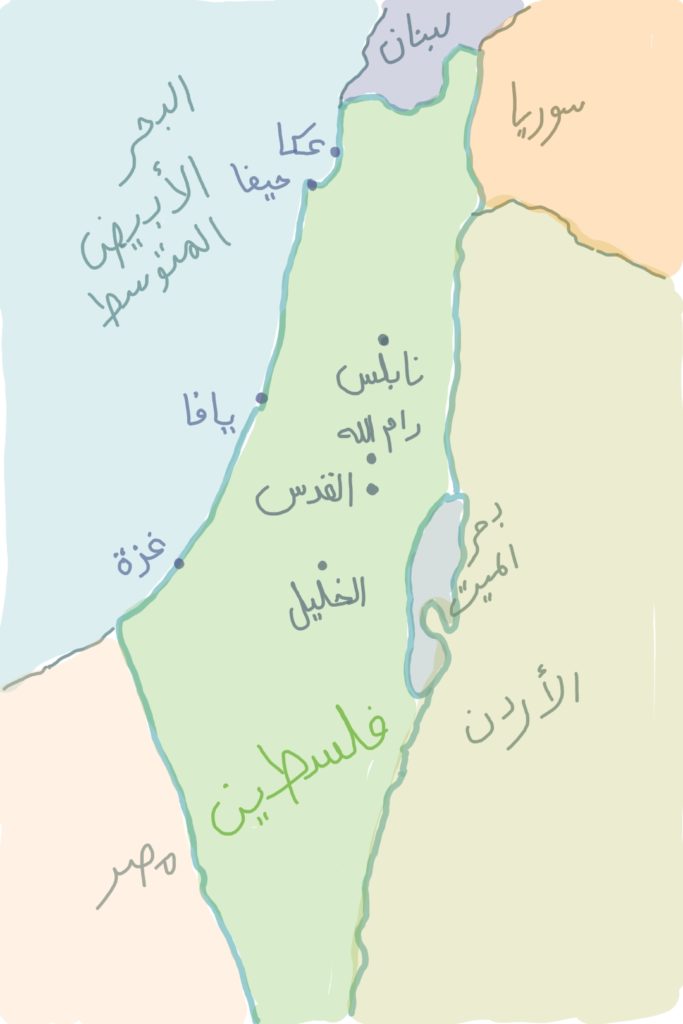The Enduring Art of Traditional Palestinian Tiles Part Two Posted by yasmine on Feb 16, 2022 in Arabic Language, Palestine
Welcome back to part two of this post about the struggle in trying to preserve الحفاظ على a part of Palestinian heritage تراث فلسطيني which is that of making traditional decorative tiles البلاط التقليدي المزخرف.
You will hear the reporter speaking in لغة عربية فصحى and the men who work with these tiles speak Palestinian Levantine dialect اللهجة الشامية الفلسطينية.
I have transcribed and translated the clip so you can read along as you listen if needed, as well as help you answer the comprehension questions that follow.
مصنع “أصلان” أول وآخر معاقل البلاط المزخرف والملون في فلسطين
We will continue the second part of the clip from minute (1:13) to the end.
هذا البلاط المصنوع من صخور جبال نابلس والذي زين وأسس بيوت الفلسطينيين في عكا وحيفا وأسس بيوت العربي في الشام ولبنان والأردن قبل قرن من الزمن. يواجه اليوم أزمة تسويقية وانعدام الطلب إلا من بعض المنشآت الثقافية والمراكز التراثية بالإضافة إلى استخدامه في ترميم البيوت القديمة في فلسطين المحتلة عام ٤٨
These tiles made from the rocks of the mountains of Nablus decorated and established the homes of Palestinians in Acre and Haifa, and the foundations of Arab homes in the Levant that of Lebanon and Jordan a century ago. Today, it is facing a marketing crisis and a lack of demand except for some cultural facilities and heritage centers. In addition to its use in the restoration of old houses of occupied Palestine in 1948.
من ماذا مصنوع هذا البلاط؟
اذكر المدن الفلسطينية والدول العربية التي أسس هذا البلاط بيوتها
كم سنة موجودة في “قرن” من الزمن؟
من الذي ما زال يطلب هذا البلاط اليوم؟
What are these tiles made of?
Mention the Palestinian cities and the Arab countries whose homes these tiles established.
How many years are there in a “قرن”?
Who is still ordering these tiles today?
كل بيوت نابلس القديمة، أو ٩٩% من بيوت نابلس القديمة الي اعمارها فوق الخمسين والخمسة وخمسين سنة مبلط منها. رام الله في عندك الخليل برضو كمية كبيرة. يافا، كل بيوت يافا القديمة انو الرسمات الي بيافا أصله شغلنا لأنو كل القوالب الموجودة بيافا كلها موجودة عندنا. لأنو كان عندنا فرع بيافا بالزمانات، احن عرضوا الإسرائيليين علينا يوم من الأيام ننقل المصنع إلى منطقة يافا بشرط انو هذا بدو يكون منتج اسرائيلي وليس فلسطيني. أنا الإرث الفلسطيني اقبل عنجد أنا الجيل الرابع والجيل الخامس شغال؟ هدا يصير منتج اسرائيلي فهذا مرفوض من ناحية وطنية بالنسبة الي نهائيا مرفوض
All the old houses of Nablus, or 99% of the old houses of Nablus over fifty and fifty-five years old, have these tiles. Ramallah, Hebron, also have a large amount, and Jaffa, all the houses of old Jaffa. The designs in Jaffa are originally our work, because all the molds in Jaffa are all here. Because we had a Jaffa branch over the years, the Israelis offered us one day to move the factory to the Jaffa area, on the condition that this become an Israeli product and not a Palestinian one. Me being from the fourth and fifth generation working with this Palestinian heritage, accept this, really? For this to become an Israeli product is totally unacceptable from a national point of view and from mine.
كم اعمار البيوت النابلسية المبلطة بهذا البلاط؟
ماذا عرضوا الإسرائيليين على هذا المصنع؟
ماذا كان رد فعل الفلسطينيين؟
How old are the Nabulsi houses which are tiled with these tiles?
What did the Israelis offer this factory?
What was the Palestinian’s reaction?
أرضيات البيوت المسروقة في عكا ويافا وحيفا والمنازل الخالية من الأعزاء في نابلس ورام الله وغزة ما زالت تدافع إلى الآن بتاريخ عن عراقتها وأصالتها. ام الخوف اليوم فعلى هذا المكان بكل ما يحمله من جمال وأصالة
The floors of the stolen homes in Acre, Jaffa, and Haifa, and the empty homes in Nablus, Ramallah and Gaza, still defend their heritage and authenticity to this day. But the fear today, is for this place with all its beauty and originality.
على ماذا تدافع هذه المدن الفلسطينية؟
أين تقع كل هذه المدن الفلسطينية المذكورة على الخريطة؟
What are these Palestinian cities defending?
Where are all the cities mentioned located on the map?
من مدينة نابلس المحتلة، حافظ أبو صبرة، رؤية
From the occupied city of Nablus, Hafez Abu Sabra, Roya.
I hope you enjoyed learning about Palestinian heritage and history. In addition to improving your Arabic language comprehension. Till next week, happy Arabic learning! ?

Build vocabulary, practice pronunciation, and more with Transparent Language Online. Available anytime, anywhere, on any device.





